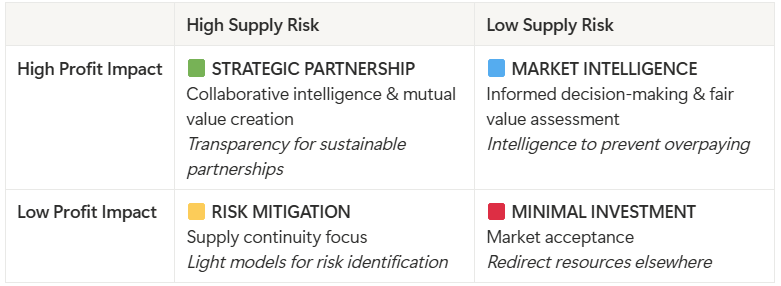The Strategic Art of Should-Cost Modeling: Where Precision Meets Pragmatism
In an era of unprecedented supply chain volatility and margin pressure, procurement leaders face a fundamental question: How do you cut through supplier pricing opacity without drowning in analysis paralysis?
The answer lies not in modeling everything, but in modeling the right things. After working with hundreds of procurement teams across industries, we've observed a clear pattern: the most successful organizations don't just build should-cost models—they build them strategically.
Beyond the Spreadsheet: What Should-Cost Really Means
At its core, a should-cost model is an exercise in commercial intelligence. It deconstructs supplier pricing into its fundamental components—raw materials, processing costs, labor, logistics, and margins—to reveal the economic reality behind quoted prices.
But here's what makes it powerful: it transforms procurement from a reactive function responding to supplier price increases into a strategic partner equipped with market intelligence. Rather than tools for squeezing suppliers, cost models serve as instrumental mediums to quantify impact, analyze risk, and identify opportunities. They create comprehensive oversight to ensure you're not being squeezed by suppliers while maintaining healthy, sustainable relationships.
The challenge? Building comprehensive models for every product (category) you are buying from suppliers is neither practical nor profitable. The solution requires strategic thinking about where creating transparency creates the most value.
The Strategic Framework: Profit Impact vs Supply Risk
The most effective cost modeling strategies are built around two critical dimensions that determine both the necessity and approach for cost modeling:
Profit Impact measures how significantly a category affects your bottom line through spend volume, margin contribution, or operational criticality. High profit impact materials demand attention because even small pricing improvements translate into meaningful financial results.
Supply Risk evaluates your vulnerability to supply disruptions and your supplier switching costs within a category. This includes the number of available suppliers, regulatory complexity, qualification requirements, and geographic concentration. High supply risk indicates limited alternatives and higher switching costs.
The intersection of these dimensions creates four distinct strategic approaches to cost modeling. This framework was originally developed by Peter Kraljic in his 1983 article “purchasing must become supply management.”
The Strategic Quadrant: A Decision Framework
🟩 Strategic Partnership: High Profit Impact + High Supply Risk
Approach: Collaborative Intelligence & Mutual Value Creation
These categories represent your most critical relationships. When both you and your supplier have significant stakes in the partnership—you need their specialized capability, they depend on your volume—cost modeling becomes a tool for mutual understanding and joint optimization.
Strategy: Use cost models to create transparency that benefits both parties. Understand where value is created, identify shared efficiency opportunities, and build fact-based discussions around fair pricing. The goal is sustainable partnerships, not adversarial negotiations.
🟦 Market Intelligence: High Profit Impact + Low Supply Risk
Approach: Informed Decision-Making & Fair Value Assessment
Here's where cost modeling delivers maximum strategic value. When you understand the true cost structure AND have supplier alternatives, you gain the intelligence needed to make informed decisions and ensure fair pricing.
Strategy: Develop detailed cost intelligence to understand market dynamics, assess pricing reasonableness, and make informed sourcing decisions. Use models to identify when market prices deviate from underlying costs and understand the reasons why. This intelligence protects against both overpaying and unrealistic expectations
🟨 Risk Mitigation: Low Profit Impact + High Supply Risk
Approach: Supply Continuity Focus
While these categories don't drive profits, supply disruption can still halt operations. Cost modeling here focuses on understanding where supply chain vulnerabilities lie rather than optimizing pricing.
Strategy: Use lighter cost models to identify risk points (transport chokepoints, regulatory dependencies, geographic concentrations) and develop contingency plans. Focus on supply security over cost optimization.
🟥 Minimal Investment: Low Profit Impact + Low Supply Risk
Approach: Market Acceptance
These categories simply don't justify significant analytical investment. Accept market pricing and redirect your modeling resources toward higher-value opportunities.
Strategy: Implement automated benchmarking, catalog-based purchasing, or light monitoring. Invest your analytical resources elsewhere.

Supply Chain Position: Context Matters
Your position in the value chain significantly influences modeling effectiveness:
Primary Production & Retail: Cost modeling typically delivers limited value due to market-driven pricing and limited processing complexity.
Processing & Manufacturing: The sweet spot for cost modeling, where understanding input costs, processing parameters, and operational efficiency drives significant value.
Recipe-Based Manufacturing: Particularly valuable for complex formulations combining multiple ingredients, where small optimizations in component costs aggregate to meaningful savings.
When Modeling Creates Maximum Value
The highest-return scenarios for cost modeling share common characteristics:
Market Intelligence Needs: Categories with limited price transparency or complex cost structures benefit most from independent analysis. Your model becomes essential intelligence for understanding the true market dynamics rather than relying solely on supplier information.
Impact Quantification: When raw material costs fluctuate significantly, accurate cost models become essential for quantifying the impact on your business, understanding price change drivers, and making informed strategic decisions. The ability to analyze and anticipate rather than simply react transforms business planning.
Risk Analysis: Cost models excel at identifying where value is created and where vulnerabilities exist. They provide the analytical foundation for understanding supply chain dependencies and making informed risk management decisions.
Stakeholder Communication: Detailed cost breakdowns provide credibility when explaining market dynamics to management, justifying budget adjustments, or building business cases for strategic initiatives.
The Disciplines of Strategic Modeling
Successful should-cost programs share several operational principles:
Intelligence-Driven Approach: Recognize that cost models are strategic intelligence tools, not weapons. High-risk categories require collaborative transparency rather than adversarial positioning.
Tiered Approach: Treat modeling intensity as a strategic resource. Reserve deep analysis for high-leverage categories while maintaining lighter oversight elsewhere.
Dynamic Maintenance: Markets evolve, supply chains shift, and cost structures change. Static models quickly become historical artifacts rather than decision-making tools.
Cross-Functional Integration: The most valuable models connect procurement insights with finance planning, operations requirements, and commercial strategy. Isolated analysis rarely drives organizational change.
Common Pitfalls: When Cost Models Mislead
Historical Price Traps: Building cost models on potentially incorrect historical pricing can perpetuate years of overpaying or underpaying. Should-cost models work bottom-up from true cost components, not top-down from existing prices.
Adversarial Positioning: Treating cost models as tools to pressure suppliers can damage valuable relationships and miss opportunities for mutual value creation. The goal should be informed decision-making, not confrontation.
Static Risk Assessment: Supply risk changes with market conditions, regulations, and supplier consolidation. Regular reassessment ensures your strategy remains aligned with reality.
Looking Forward: The Evolution of Cost Intelligence
The future of should-cost modeling lies not in more detailed spreadsheets but in more intelligent automation. Modern platforms can continuously monitor external data, update cost assumptions, and flag significant variances—allowing procurement professionals to focus on strategy rather than data management.
This technological evolution enables a more sophisticated approach: real-time cost intelligence that supports dynamic decision-making rather than periodic analysis, while maintaining the strategic framework that determines where and how to apply cost modeling effectively.
The Strategic Imperative
Should-cost modeling, done right, represents more than operational efficiency—it's strategic intelligence. Organizations that understand their true cost positions can navigate volatile markets with confidence, make informed sourcing decisions, and build sustainable supplier relationships based on mutual understanding rather than information asymmetry.
The key is recognizing that not every category deserves the same level of analysis, and that supply risk fundamentally shapes your strategic approach. By focusing your modeling efforts where they create the most value—as tools for quantifying impact, analyzing risk, and identifying opportunities—you transform cost modeling from an adversarial exercise into a strategic capability that protects your interests while fostering healthy supplier relationships.
In a world where supply chain transparency increasingly determines competitive advantage, the question isn't whether to build should-cost models—it's where to build them first, and how to use them as instruments of strategic intelligence rather than supplier pressure.









.png)
.png)